Introduction
Hi, I’m Rudy Maxa. We’re traveling the English countryside, a land of mythic castles, ruined abbeys, and prehistoric monuments. And they all have a story to tell! Now, it’s The English Countryside on Smart Travels.
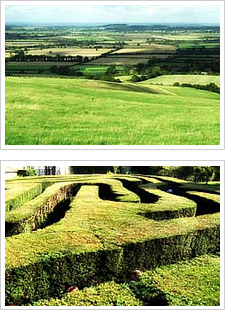 Most visitors to England begin in London, and some never move beyond it. But there’s much, much more to this island nation.
Most visitors to England begin in London, and some never move beyond it. But there’s much, much more to this island nation.
The country outside of London echoes with storybook images. Around each bend are garden mazes, majestic manors and hallowed halls of learning. Here history entwines with literary imagination to create a potent English brew.
This time we’re exploring the stunning countryside within easy reach of England’s biggest city. We’ll leave London stopping at Hampton Court and then head to Oxford, Stonehenge, and the ancient town of Winchester.
"...She ran across the field after it, and fortunately was just in time to see it pop down a large rabbit-hole under the hedge. In another moment down went Alice after it, never once considering how in the world she was to get out again.”
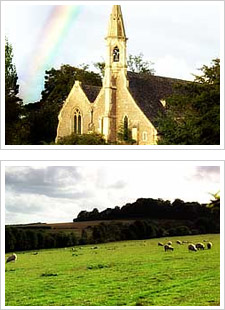 How many of us were raised on Alice’s Adventures in Wonderland? Or maybe you favored tales of King Arthur and Camelot? Perhaps Jane Austen is your cup of tea?
How many of us were raised on Alice’s Adventures in Wonderland? Or maybe you favored tales of King Arthur and Camelot? Perhaps Jane Austen is your cup of tea?
Like a trip through the looking glass, the English countryside brings all these childhood images to life. It’s hedgerows, mantles of green woods, and tantalizing traces of prehistoric realms. This is the country that inspired luminaries such as William Wordsworth, Geoffrey Chaucer, and Thomas Hardy…where Saxon kings battled Norman invaders, and Merlin the Magician wielded his wand.
Here, storytelling is second nature, and a fertile history nourishes the imagination.
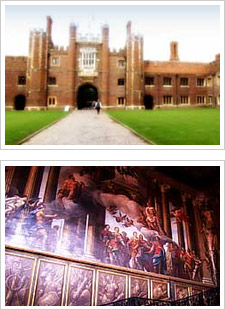 We’re starting our adventure at Hampton Court, just thirteen miles from London and an easy day-trip by train.
We’re starting our adventure at Hampton Court, just thirteen miles from London and an easy day-trip by train.
Hampton Court is the finest of Tudor palaces. It exudes royal history. Cardinal Wolsey, Henry VIII’s Lord Chancellor, built Hampton Court five hundred years ago. He wanted it to be the grandest palace in all the land.
He was so successful that Henry became envious. After Wolsey fell from favor, he offered the palace to Henry in an attempt to regain the king’s good graces. It didn’t work, but Henry took the palace anyway. Old enemies of Wolsey’s managed to charge the cardinal with treason and he died on the way to trial.
 Henry VIII changed the course of English history when he asked the Roman Catholic church to annul his marriage to his first wife, Catherine of Aragon. The Pope refused. Henry divorced Catherine anyway and decided that England would now a Protestant country.
Henry VIII changed the course of English history when he asked the Roman Catholic church to annul his marriage to his first wife, Catherine of Aragon. The Pope refused. Henry divorced Catherine anyway and decided that England would now a Protestant country.
Henry moved to Hampton Court with his wife du jour, Anne Boleyn. The marriage lasted three years until Henry wanted another new wife and had Anne beheaded.
 The cavernous Tudor kitchens are the most extensive 16th-century kitchens surviving anywhere in Europe. They’re laid out to prepare a feast using only the utensils that would have been used in Henry’s day.
The cavernous Tudor kitchens are the most extensive 16th-century kitchens surviving anywhere in Europe. They’re laid out to prepare a feast using only the utensils that would have been used in Henry’s day.
TIP
Care to try your hand at making a fine meal of Salmon and Fish Fig Pie? Go to www.hrp.org.uk for more about the daily workings of the Hampton Court kitchens...and a Tudor recipe that would have been served at the Palace.
Over the centuries other regal residents commissioned new touches. Brilliant architect Christopher Wren was hired to remodel large sections of the palace. And the magnificent grounds were inspired by the gardens at Versailles.
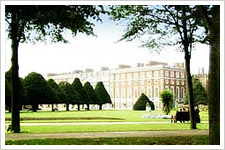 While royals, such as William III and Mary II, have left their mark on Hampton Court, the legacy of Henry VIII lingers. Some say that the ghost of Catherine Howard, another of Henry’s ill-fated wives, still haunts the grounds.
While royals, such as William III and Mary II, have left their mark on Hampton Court, the legacy of Henry VIII lingers. Some say that the ghost of Catherine Howard, another of Henry’s ill-fated wives, still haunts the grounds.
TIP
For more on Catherine Howard and the haunting of Hampton Court, visit savvytraveler.publicradio.org.
 We’re picking up a rental car to explore countryside. You could continue your "out of London" travels on the train, but driving here can sometimes be your best option.
We’re picking up a rental car to explore countryside. You could continue your "out of London" travels on the train, but driving here can sometimes be your best option.
Renting a car in Europe is easier and less expensive if you make arrangements from home. Any travel agency or car rental agency can help you. A car is especially handy if you’re visiting the more remote towns and villages.
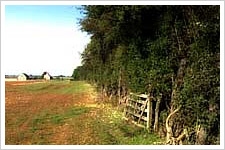 Driving here takes a bit of practice, though, since as you likely know, they drive on the left hand side of the road. But once you get the hang of it, it’s not too tough.
Driving here takes a bit of practice, though, since as you likely know, they drive on the left hand side of the road. But once you get the hang of it, it’s not too tough.
Getting off the beaten path is certainly worth the effort. Your reward is rustic beauty and quiet charm. Rural England is a collage of greens…moss, and ivy, and country roads covered by a canopy of trees.
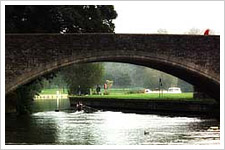 Our next stop is Oxford, home to England’s oldest university. In Saxon times, Oxford was a place where oxen forded the Thames River.
Our next stop is Oxford, home to England’s oldest university. In Saxon times, Oxford was a place where oxen forded the Thames River.
A Saxon princess founded the city in the 8th century and medieval Carfax tower still marks an ancient crossroads.
To walk the streets of Oxford is to follow the steps of some of Britain's greatest writers, scientists and politicians.
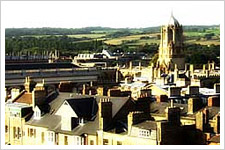 This is ultimate university town with terrific bookstores, active river sports, and a lively student atmosphere. The often-quoted poet Matthew Arnold described Oxford as “that sweet city with her dreaming spires”.
This is ultimate university town with terrific bookstores, active river sports, and a lively student atmosphere. The often-quoted poet Matthew Arnold described Oxford as “that sweet city with her dreaming spires”.
A short walk in almost any direction will lead to one of the town’s 36 colleges, the earliest of which date to the 13th century. The main street through town is known as “The High Street”. Many consider it one of the most beautiful streets in Europe. It’s lined with noble structures cloaked in 800 years of academic tradition and history.
TIP
Cars are prohibited on many Oxford streets. Pick up a city street map from the tourist office or go to the Oxford City Council website. There, you'll find a map (pdf file) displaying restricted streets with dashed lines as well as showing the Park & Ride lots situated all around the city center.
Nearby is one of the world’s great libraries. The Bodleian Library houses over 6 million volumes, including thousands of precious manuscripts.
 The most spectacular college may be Christ Church, which boasts the city's cathedral. It’s impressive roster of former students includes King Edward VII, and writer Lewis Carroll, author of "Alice in Wonderland".
The most spectacular college may be Christ Church, which boasts the city's cathedral. It’s impressive roster of former students includes King Edward VII, and writer Lewis Carroll, author of "Alice in Wonderland".
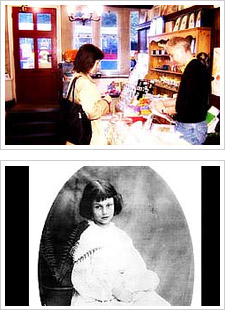 Lewis Carroll, whose real name was Charles Dodgson, was a mathematics instructor at Oxford. He captivated the world with his children’s fantasy novels: Alice's Adventures in Wonderland and Through the Looking Glass.
Lewis Carroll, whose real name was Charles Dodgson, was a mathematics instructor at Oxford. He captivated the world with his children’s fantasy novels: Alice's Adventures in Wonderland and Through the Looking Glass.
This little shop, just down the street from Christ Church, is where the real Alice in Wonderland used to buy candy and sweets.
Carroll based his intrepid main character on Alice Liddell, the daughter of the dean of Christ Church.
TIP
To take an on-line look at the original version of Alice's Adventures in Wonderland written in the author's own hand, visit the British Museum and click on THE ORIGINAL ALICE near the top right of the page.
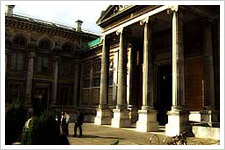 The nearby Ashmolean Museum is the oldest museum in England and one of most impressive in the world. The collection was started by a 17th century naturalist who, along with his son, traveled the globe collecting curiosities from as far away as Asia, Africa and the colonies of North America. Father and son were both master gardeners to the Crown of England. They had an avid interest not only in unusual plants, but in all the “rarities” of the world. The collection includes a famed gold and enamel jewel that was commissioned by Alfred the Great, England’s early Saxon king. “The Hunt in the Forest” is one of the very few existing
The nearby Ashmolean Museum is the oldest museum in England and one of most impressive in the world. The collection was started by a 17th century naturalist who, along with his son, traveled the globe collecting curiosities from as far away as Asia, Africa and the colonies of North America. Father and son were both master gardeners to the Crown of England. They had an avid interest not only in unusual plants, but in all the “rarities” of the world. The collection includes a famed gold and enamel jewel that was commissioned by Alfred the Great, England’s early Saxon king. “The Hunt in the Forest” is one of the very few existing 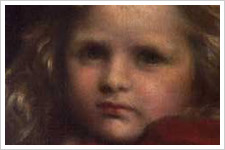 paintings by Paolo Uccello, an important figure during the Renaissance and a pioneer of perspective. And in this glass case is a cloak decorated with shells that belonged to Powhattan, father of Pocahontas. I’m especially fond of the vividly beautiful Pre-Raphaelite paintings. This 19th century English movement promoted the spirit of Italian art before Raphael and the High Rennaissance.
paintings by Paolo Uccello, an important figure during the Renaissance and a pioneer of perspective. And in this glass case is a cloak decorated with shells that belonged to Powhattan, father of Pocahontas. I’m especially fond of the vividly beautiful Pre-Raphaelite paintings. This 19th century English movement promoted the spirit of Italian art before Raphael and the High Rennaissance.
 To get the true English experience, you have to stop by a pub. The Trout Inn, just on the outskirts of Oxford, was constructed in the 17th century from the ruins of an old abbey. This atmospheric location was used to film the popular Inspector Morse television series.
To get the true English experience, you have to stop by a pub. The Trout Inn, just on the outskirts of Oxford, was constructed in the 17th century from the ruins of an old abbey. This atmospheric location was used to film the popular Inspector Morse television series.
Pubs are time-honored English institutions. Pub is short for “Public House”, and for centuries they’ve prevailed over churches and marketplaces as the preferred social gathering spots. The favored English beer is a "bitter".
It’s a dark beer that’s pumped by hand from a cellar and served at room temperature. Pubs are a great place to sample basic English "meat-and-two-veg" dishes such steak and kidney pie, or bangers and mash.
 After lunch, we’ve been invited to drop in on England’s national pastime—a football match (that’s soccer to you and me). The season lasts from mid-August through May and the British are utterly passionate about the sport. In the middle ages, football matches involved hundreds of players. They were essentially battles between the young men of rival villages, often used to settle long-standing grudges. Today, tickets to lower division matches are easy to come by, but to see premier league teams, like Arsenal or Manchester United, contact the individual clubs well in advance.
After lunch, we’ve been invited to drop in on England’s national pastime—a football match (that’s soccer to you and me). The season lasts from mid-August through May and the British are utterly passionate about the sport. In the middle ages, football matches involved hundreds of players. They were essentially battles between the young men of rival villages, often used to settle long-standing grudges. Today, tickets to lower division matches are easy to come by, but to see premier league teams, like Arsenal or Manchester United, contact the individual clubs well in advance.
 It’s not a problem finding accommodations in Oxford and the surrounding areas. Britain is actually the birthplace the Bed & Breakfast so choices throughout the countryside abound. Contact the local tourist offices for B&B information
It’s not a problem finding accommodations in Oxford and the surrounding areas. Britain is actually the birthplace the Bed & Breakfast so choices throughout the countryside abound. Contact the local tourist offices for B&B information
TIP
Contact the local tourist offices for B&B information. For the city of Oxford, check out Where To Stay In Oxford on the Oxford City Council website.
From Oxford we’re just a short drive from medieval towns, rustic villages and authentic country estates.
Before the Norman Conquest, forests stretched across this entire part of England. Royalty kept hunting lodges in Woodstock, a little town about eight miles northwest of Oxford is the town of Woodstock. Everyone from Alfred the Great to Ethelred the Unready thought this was town enough to fit a king.
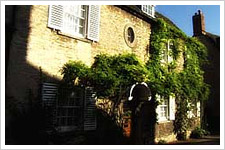 The poet Geoffrey Chaucer lived here for a time. Chaucer has come to be considered one of the most important figures in English literature. And his brilliant 17,000-line poem, The Canterbury Tales, is judged a literary masterpiece.
The poet Geoffrey Chaucer lived here for a time. Chaucer has come to be considered one of the most important figures in English literature. And his brilliant 17,000-line poem, The Canterbury Tales, is judged a literary masterpiece.
Centuries ago, glove-making was Woodstock's chief industry, but the town now prospers more from visitors eager to visit nearby Blenheim Palace.
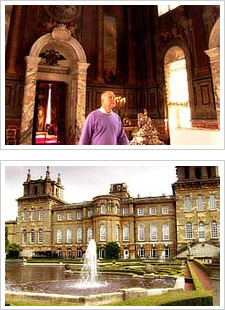 The magnificent palace was built for John Churchill, the first Duke of Marlborough. It was a gift of gratitude from the queen for the Duke’s victory over the French in the early eighteenth century. Stunningly elegant, this architectural marvel should be on the must-see list of every visitor to this part of the country. The saga of Blenheim’s construction is worthy of a great epic novel, filled with ambition and strife. The Duke himself never lived to see it completed. When Parliament backed out on funding, the Duke’s widow raised the money and threw herself into completing this gilded masterpiece. The eleventh Duke of Marlborough, the original owner’s descendent, still lives in the palace.
The magnificent palace was built for John Churchill, the first Duke of Marlborough. It was a gift of gratitude from the queen for the Duke’s victory over the French in the early eighteenth century. Stunningly elegant, this architectural marvel should be on the must-see list of every visitor to this part of the country. The saga of Blenheim’s construction is worthy of a great epic novel, filled with ambition and strife. The Duke himself never lived to see it completed. When Parliament backed out on funding, the Duke’s widow raised the money and threw herself into completing this gilded masterpiece. The eleventh Duke of Marlborough, the original owner’s descendent, still lives in the palace.
Another illustrious relative, Sir Winston Churchill, was born at Blenheim in 1874 and is buried nearby.
TIP
For more on Blenheim Palace and its history, check out www.blenheimpalace.com.
Blenheim Palace Pleasure Garden ![]()
 The Duke of Marlborough lives in old English style, with hundreds of acres of rolling hillsides, formal water terraces and perfectly manicured gardens. And there’s something special for visitors, too. Adjacent to the palace is a "pleasure garden", where you can stroll through a miniature model of Woodstock, and play on oversized checkerboards. While away the afternoon in the wondrous butterfly house, which flutters with the delicate creatures. The highlight of the park may be the winding garden maze. This is the world’s largest symbolic hedge maze sheared to
The Duke of Marlborough lives in old English style, with hundreds of acres of rolling hillsides, formal water terraces and perfectly manicured gardens. And there’s something special for visitors, too. Adjacent to the palace is a "pleasure garden", where you can stroll through a miniature model of Woodstock, and play on oversized checkerboards. While away the afternoon in the wondrous butterfly house, which flutters with the delicate creatures. The highlight of the park may be the winding garden maze. This is the world’s largest symbolic hedge maze sheared to  represent military images. The tradition of English garden mazes dates back to at least Henry II’s reign. Legend holds that Henry built an elaborate maze in which to hide his mistress. Since no one else knew the correct path, Henry could meet with her there secretly. They would have been safe from me – I’ve barely found my way out of this shrubbery labyrinth.
represent military images. The tradition of English garden mazes dates back to at least Henry II’s reign. Legend holds that Henry built an elaborate maze in which to hide his mistress. Since no one else knew the correct path, Henry could meet with her there secretly. They would have been safe from me – I’ve barely found my way out of this shrubbery labyrinth.
TIP
For a map of the palace grounds, download the brochure (pdf format) at www.blenheimpalace.com.
We’re off to visit Abingdon, a village just south of Oxford.
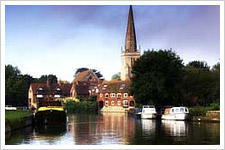 This site was settled in ancient times and became a flourishing town during England’s Roman period. But its days of glory came as the site of an early Benedictine abbey. In the 7th century, a nephew of the king was granted land for founding monastery on this site. This gateway once opened into the influential abbey.
This site was settled in ancient times and became a flourishing town during England’s Roman period. But its days of glory came as the site of an early Benedictine abbey. In the 7th century, a nephew of the king was granted land for founding monastery on this site. This gateway once opened into the influential abbey.
During the middle ages, monasteries became the centers of power in the country. Benedictine orders were an important part of the old feudal system. Their control was so complete that in the 14th century the townspeople here (with the help of the mayor and Oxford students) rose up in rebellion against the monks.
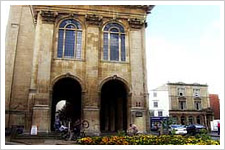 But it wasn’t until two hundred years later, when Henry VIII dissolved the monasteries that Abingdon Abbey fell from power. At the time, it was one of the richest abbeys in the country. Still standing is the restored Checker Hall (or counting house), which is now used as an Elizabethan-style theatre. Today, fishermen fill the banks of the nearby Thames river, and boats wait patiently to pass through Abingdon’s picturesque lock.
But it wasn’t until two hundred years later, when Henry VIII dissolved the monasteries that Abingdon Abbey fell from power. At the time, it was one of the richest abbeys in the country. Still standing is the restored Checker Hall (or counting house), which is now used as an Elizabethan-style theatre. Today, fishermen fill the banks of the nearby Thames river, and boats wait patiently to pass through Abingdon’s picturesque lock.
TIP
A great way to get to know Abingdon is on foot. Visit abingdonwalks.co.uk for walks (including photos and maps). The Inner Town Walk covers many of the locations featured in this show.
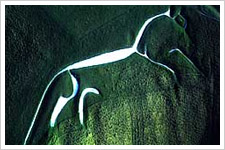 The Vale of White Horse is a rich clay valley that stretches south for about 17 miles. The valley takes its name from the gigantic prehistoric figure of a horse carved into the hillside. The carvers removed the turf to reveal the white, chalky subsoil. Theories abound as to who carved it and why, but the fact is nobody really knows. The simplest theory is that it was just an ancient road sign.
The Vale of White Horse is a rich clay valley that stretches south for about 17 miles. The valley takes its name from the gigantic prehistoric figure of a horse carved into the hillside. The carvers removed the turf to reveal the white, chalky subsoil. Theories abound as to who carved it and why, but the fact is nobody really knows. The simplest theory is that it was just an ancient road sign.
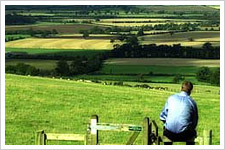 This fertile, rolling countryside reverberates with history and myth. You’ll pass the hill where some claim St. George slew his dragon. And crossing campgrounds that date to the Iron Age, you’ll be awed by sweeping, panoramic views.
This fertile, rolling countryside reverberates with history and myth. You’ll pass the hill where some claim St. George slew his dragon. And crossing campgrounds that date to the Iron Age, you’ll be awed by sweeping, panoramic views.
TIP
For more about the chalk horses in this area (Wiltshire), check out wiltshirewhitehorses.org.uk.
About an hour’s drive away is the most famous and puzzling prehistoric monument in Europe. It inspires awe in all who visit. Stonehenge is a circle of upright ancient stones standing alone on the open chalk downs of Salisbury Plain.
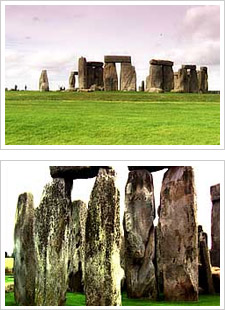 What’s amazing about this stone circle is that it dates to before 3000 BC. Scholars don’t know exactly why or even how it was built. Some evidence to suggests this was used as place of religious worship, of sacrifice to the moon and the sun, or as site for festivals.
What’s amazing about this stone circle is that it dates to before 3000 BC. Scholars don’t know exactly why or even how it was built. Some evidence to suggests this was used as place of religious worship, of sacrifice to the moon and the sun, or as site for festivals.
A henge is an earthen rampart usually enclosing a wood or stone circle. These 50-ton sandstone pieces were carved from rock found some 20 miles away, and it’s not clear how they were moved to this site.
Just inside the earthen bank are two of four original Station Stones that may have been used for charting the movement of the planets. The Heel Stone casts a shadow directly into the heart of Stonehenge at midsummer. During the summer solstice each year, people gather here to watch the sun rise in perfect alignment to the circle. Some believe that Stonehenge's builders had a sophisticated knowledge of astronomy. In fact, Stonehenge is located at the only latitude in England at which the extremes of the sun's rising and setting are at right angles to one another.
TIP
Take a look at Stonehenge (and other sites around the globe) as seen from earth orbit.
We’re off in search of more English lore in the esteemed city of Winchester.
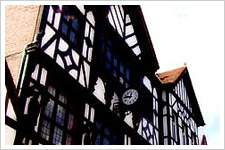 Winchester is the quintessential English city. It proudly touts an ancient heritage and impeccably regal credentials. It’s sometimes referred to as the “City of Kings”. Here, monarchs lived, ruled, died, and bishops vied for power.
Winchester is the quintessential English city. It proudly touts an ancient heritage and impeccably regal credentials. It’s sometimes referred to as the “City of Kings”. Here, monarchs lived, ruled, died, and bishops vied for power.
A thousand years ago in Alfred the Great's time, this was England’s Royal City. And William the Conqueror based his government here.
 Portions of William’s castle still remain. The Great Hall was the heart of the castle, and it was here that Kings met with barons and held court to administer justice. The hall holds a mysterious roundtable that supposedly was used by King Arthur and his noble knights. The historical facts of King Arthur’s life have become impossibly mixed with fiction and myth. There most likely was an Arthur, a 5th-century leader who defended the British against the Saxon invasions. Arthur appears in both pagan and Christian legends.
Portions of William’s castle still remain. The Great Hall was the heart of the castle, and it was here that Kings met with barons and held court to administer justice. The hall holds a mysterious roundtable that supposedly was used by King Arthur and his noble knights. The historical facts of King Arthur’s life have become impossibly mixed with fiction and myth. There most likely was an Arthur, a 5th-century leader who defended the British against the Saxon invasions. Arthur appears in both pagan and Christian legends.
 The Christian version focuses on the search for the Holy Grail – the cup that Jesus drank from at the Last Supper and was believed to have been brought to England. Though we’ll probably never know the true story of Arthur, the endurance of the Arthurian myth reflects the human love of storytelling and our wistful dreams of an ideal age.
The Christian version focuses on the search for the Holy Grail – the cup that Jesus drank from at the Last Supper and was believed to have been brought to England. Though we’ll probably never know the true story of Arthur, the endurance of the Arthurian myth reflects the human love of storytelling and our wistful dreams of an ideal age.
TIP
If the Aurthurian legend fascinates you, read on at www.kingarthursknights.com.
 At first glance, Winchester Cathedral seems unassuming, a sedate church set peacefully in a garden. But step through the doors and those impressions quickly fade. The stunning 556-foot Gothic nave is the longest in Europe. In the choir, medieval monks sang their eight daily services and celebrated high mass. Above, a carved woodland scene shows a knight with his sword at the ready, and a falconer with his bird of prey. For nine hundred years this has been a sacred place of worship and prayer. It so inspired the congregation that at one point when
At first glance, Winchester Cathedral seems unassuming, a sedate church set peacefully in a garden. But step through the doors and those impressions quickly fade. The stunning 556-foot Gothic nave is the longest in Europe. In the choir, medieval monks sang their eight daily services and celebrated high mass. Above, a carved woodland scene shows a knight with his sword at the ready, and a falconer with his bird of prey. For nine hundred years this has been a sacred place of worship and prayer. It so inspired the congregation that at one point when 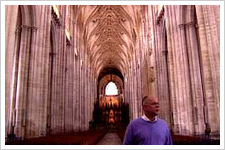 the cathedral was in danger of sinking into the marshy land below, this devoted parishioner swam beneath the church and single-handedly reinforced the foundation.
the cathedral was in danger of sinking into the marshy land below, this devoted parishioner swam beneath the church and single-handedly reinforced the foundation.
Among the church’s gravestones, is a name familiar to fans of romantic English fiction – Jane Austen. Austen spent most of her life in this part of England.
 After her father’s death, Jane Austen, her mother and her sister Cassandra moved here to the town of Chawton, just 17 miles from Winchester.
After her father’s death, Jane Austen, her mother and her sister Cassandra moved here to the town of Chawton, just 17 miles from Winchester.
Before she came to this house, none of Austen’s work had been published. The period that she lived here was the most prolific and productive of her life. She loved the country, and she found the inspiration here to write such classics as Pride & Prejudice, Emma and Sense & Sensibility. Austen based her characters and settings on her large circle of friends and their frequent social gatherings. She was an astute observer of human behavior and had a gift for making ordinary daily life intriguing.
Nearly two centuries after her death, Austen’s popularity continues to grow. New fans relish her witty style and her perceptive descriptions of country life.
TIP
Take an on-line read of Jane Austen's hand-written History of England. This book parodies the standard schoolroom books of her day and was written when the author was fifteen. Go to the British Museum and click on JANE AUSTEN'S EARLY WORK near the top center of the page.
The Most Perfect Refreshment... ![]()
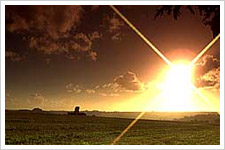 The English countryside seems of another time, another place. Yet thanks to the pages of history and our favorite storytellers, it’s somehow familiar too. These tranquil fields and green woods can’t help but renew the youthful spirit of any traveler.
The English countryside seems of another time, another place. Yet thanks to the pages of history and our favorite storytellers, it’s somehow familiar too. These tranquil fields and green woods can’t help but renew the youthful spirit of any traveler.
As Fanny Price in Mansfield Park said: "To sit in the shade on a fine day, and look upon verdure is the most perfect refreshment."
Thanks for joining me on our adventure Out of London!
- Introduction
- Hampton Court
- Driving in England
- Oxford
- Bodleian Library
- Christ Church
- Lewis Caroll & Alice Liddell
- Ashmolean Museum
- The Trout Inn
- Football
- B&Bs
- Woodstock
- Blenheim Palace
- Blenheim Palace Pleasure Garden
- Abingdon
- The Vale of White Horse
- Stonehenge
- Winchester
- The Great Hall
- Winchester Cathedral
- Jane Austen
- The Most Perfect Refreshment

Interested in planning your vacation to England?
Start your trip at
Expedia.com/United Kingdom
Links
Cars are prohibited on many Oxford streets. Pick up a city street map from the tourist office or go to the Oxford City Council website. There, you'll find a map (pdf file) displaying restricted streets with dashed lines as well as showing the Park & Ride lots situated all around the city center.
Contact the local tourist offices for B&B information. For the city of Oxford, check out Where To Stay In Oxford on the Oxford City Council website.
For more on Blenheim Palace and its history, check out www.blenheimpalace.com.
